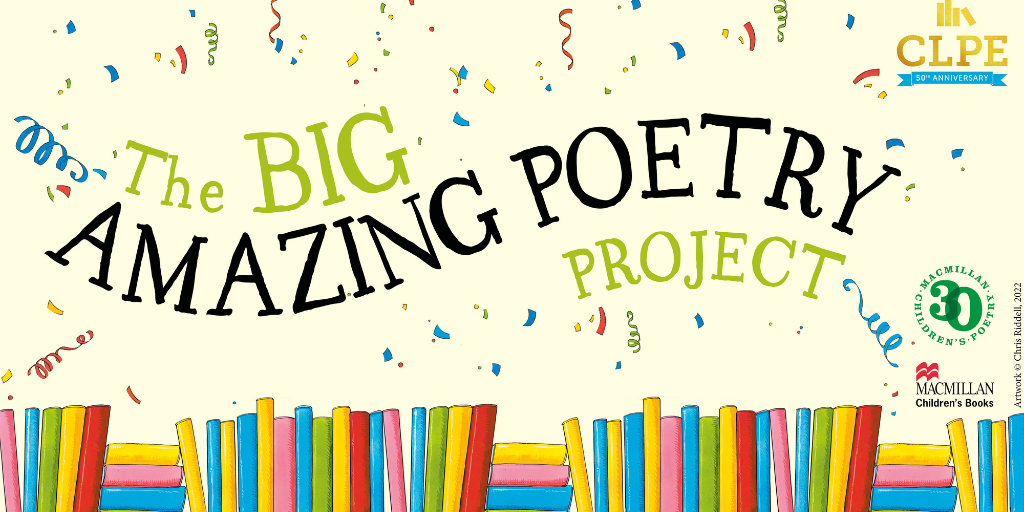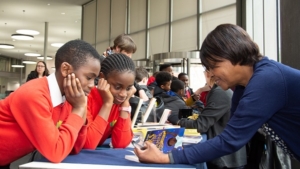
O Tell Me the Truth About Poetry in Schools
CLPE, the National Poetry Centre for Primary Schools, with the support of Macmillan Children’s Books, have just published the results of a survey into the place of poetry in primary schools, intended to provide a picture of poetry practice and provision in primary schools, and help understand what support teachers and children need. If you took the headlines in the press as a guide, things seem very bleak: ‘Many UK primary schoolchildren ‘drastically’ missing out on poetry’ reported the Guardian, but there is much in the findings that is encouraging.
For example:
- 80% of teachers said that they thought poetry was a significant part of a literacy curriculum, evidence that they value the place of poetry as part of children’s developing literacy.
- Teachers also reported that children really enjoy hearing, writing and performing poetry.
 As positive as this is, it still means that one in five schools do not have poetry as a significant part of their curriculum and many of the responses to the survey recognised the considerable challenges in providing a rich experience of poetry as part of the curriculum.
As positive as this is, it still means that one in five schools do not have poetry as a significant part of their curriculum and many of the responses to the survey recognised the considerable challenges in providing a rich experience of poetry as part of the curriculum.
Despite teachers acknowledging how much children enjoy poetry, the survey found that poetry is read aloud less than once a week in 93% of schools and in nearly 20% of schools children never have the opportunity to hear a poem read aloud.
Children’s experiences of poetry
88% of teachers thought their children enjoyed engaging with poetry, with 28% of them saying they really enjoyed it.
In terms of what the children enjoy most about poetry, 89% reported that children enjoyed listening to it being read or performed and 72% reported that they enjoyed performing it themselves.
‘This reflects what we know about children’s engagement with poetry from CLPE research over the past 50 years’, says Charlotte Hacking, Learning and Programmes Director at CLPE , ‘and is why we film videos of poets performing their poetry as part of the CLiPPA shadowing scheme, and why the shadowing competition focuses on children performing a poem from one of the shortlisted collections.’
‘The best way to engage children in poetry is to make sure they hear a wide range of poetry as often as possible. It is important to hear and feel the distinct rhythms of different voices and dialects, and to see that poetry comes in different forms and can be written by a range of different people. Videos and audio performances of poets performing are a fantastic inspiration for children’s own performances .’
Yet when asking how often children get the chance to hear poems read aloud or listen to poets read their poems via audio or video, the survey found that poems are read or listened to daily in only 4% of classrooms. In 74% of primary school classrooms poems are heard or read less than once a week.
The survey also asked about how often poems were read or listened to in whole school routines, for example in assemblies. In 93% of schools this is less than once per week and 19% of schools felt they never had the opportunity to share a poem in this way.
The picture on poet visits to schools is even more depressing. Asked whether schools were able to offer children the opportunity to connect with poets directly through poet visits, 44% of teachers reported that they’d never had a poet visit. Of the schools that said they had experienced a poet visit, 42% reported that this had been 5 or more years ago.
Teachers that had experienced a poet visit were hugely positive about their impact. ‘We have had Karl Nova visit and work with us twice’ said one teacher, ‘Every pupil was fully engaged and in awe of him. They wanted to write more poetry and have the chance to share it with him.’
Not only were poet visits enjoyable and inspiring for children, there was an impact too on their confidence as well as their reading, performance and writing ability. Many teachers talked increased understanding and aspiration encounters with poets provoked in children, in terms of writing, both within and beyond the visit. They also talked about the impact pupils meeting poets they could relate to and whose poetry reflected them, their language and their experiences.
The barriers to poet visits were identified as lack of funding and the low priority of poetry in the curriculum in relation to other text types, such as non-fiction, picturebooks and novels.
Lack of poetry focused CPD is also an issue.
Three quarters of teachers (76%) plan their own units of poetry, whereas a quarter use published plans or schemes. Many teachers are aware of and use a wide variety of resources to support them in finding out more about poets and poetry to support their planning.
However, only 38% of teachers felt confident about planning units of work focussed on poetry. Many cited that they felt they didn’t have enough knowledge about poetry or experience of teaching it to do so. There was a significant link to a lack of training and development in this area of literacy. 61% of teachers told us they had never had CPD or training on poetry and only 7% of had received CPD or training on poetry in the last year.
Another issue – not restricted to poetry but across all genres – is poor book stock. In 79% of classrooms, the book corners contained fewer than 10 poetry books and in 44% of classrooms, the figure was 5 or less. ‘This is a drastically low figure if you are trying to create an environment where children can see a range of poetry and types of poetry, giving them a broad perspective of what poetry is, what it could be and who it is written by.’ Says Charlotte Hacking. ‘This also gives limited access to poetry as a free choice for independent reading or reading for pleasure. Only 21% of classrooms had a book stock of over 10 poetry books.’
Name that poet
Previous research into teacher’s knowledge of children’s poets, namely Teachers as Readers (Cremin et al, 2007) and Poetry in Schools (Ofsted, 2007) showed that too limited a range of poets were known by primary phase teachers. Responses collected in the survey showed that this has not moved on in the 16 years since those research reports were published. Aside from Joseph Coelho, who has come to prominence due to his role as Waterstones Children’s Laureate 2022-24, Valerie Bloom and Julia Donaldson, the names of the top 9 poets named by respondents matched those in the Teachers as Readers survey from 2006-7.
Barriers to poetry teaching
87% of teachers questioned said that their children had the opportunity to read poetry for themselves at least once per term and 75% said that children had the opportunity to write poetry at least once per term. However, 69% of teachers thought that there were barriers to teaching poetry in their classroom.
The most commonly cited perceived barriers were:
- Time
- Teacher knowledge
- Teacher confidence
- SLT and/or other teachers valuing the importance of poetry
- Finding it difficult to see the grammar and writing expectations in poetry
- Poetry not being prominent enough in the National Curriculum or assessments (SATs)
- Knowledge of and access to poets, poems, and poetry texts
- Lack of training
- National or school curriculum being weighted to fiction and non-fiction
- Constraints of assessment preparation
There are 26 references to poetry in the current National Curriculum in England (DFE, 2014). The majority of the references relate to children listening to or reading and responding to poems, or performing or reciting poetry.
It is only in Year 2 that poetry is specifically mentioned in relation to writing composition, although in the introduction to English in Upper Key Stage 2 (Years 5 & 6) it is stated that ‘Pupils’ knowledge of language, gained from stories, plays, poetry, non-fiction and textbooks, will support their increasing fluency as readers, their facility as writers, and their comprehension.’
While there are references to reading poetry, other than a general direction to expose children to ‘a wide range of contemporary and classic poetry’, there is no additional guidance about what this might be. ‘When we put this together with the data regarding access to poetry books in the classroom, and teachers knowledge of poets and poetry’ says Charlotte Hacking, ‘It’s easy to see why some of these barriers were mentioned by respondents.’
With significant barriers to teaching poetry, a serious lack of professional development in this area and with a substantial shortage of poetry books in class collections, there is much to do to raise the profile and recognition of the importance of poetry to children’s literacy.
What’s happening in secondary schools?
For the view from secondary schools and colleges, NATE have published the results of a National Poetry survey carried out in 2022. Themes identified include lack of opportunities for professional development (38% reporting they did not have the opportunity to develop their own expertise through training/further study); the ‘hijacking’ of KS3 to teach GCSE prescribed texts, including poetry due to exam pressures and time constraints; similar pressures restricting enrichment opportunities, despite awareness of many schemes available, including the CLiPPA, Poetry By Heart and Foyles Young Poets.
The results are available to read in full on the NATE website.
The 2023 CLiPPA shortlist will be revealed at a live online event on the afternoon of Wednesday 3rd May 2023. Its hugely popular Shadowing Scheme will launch on 15 May.
The CLPE Macmillan Children’s Books report is based on the responses of 468 people who filled in a survey in January 2023. CLPE says, ‘We are aware that this is a survey that relies on people self-referring. The survey was publicised through CLPE email and social media therefore the respondents are likely to be teachers with an interest in literacy teaching and children’s literature. They are also likely to be teachers who understand the importance of reading for pleasure and the pedagogical approaches that are effective.’





